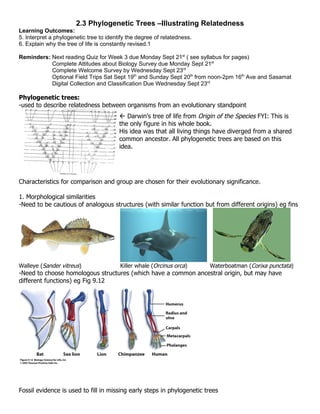
2.3 Phylogenetic Trees
- 1. 2.3 Phylogenetic Trees –Illustrating Relatedness Learning Outcomes: 5. Interpret a phylogenetic tree to identify the degree of relatedness. 6. Explain why the tree of life is constantly revised.1 Reminders: Next reading Quiz for Week 3 due Monday Sept 21st ( see syllabus for pages) Complete Attitudes about Biology Survey due Monday Sept 21st Complete Welcome Survey by Wednesday Sept 23rd Optional Field Trips Sat Sept 19th and Sunday Sept 20th from noon-2pm 16th Ave and Sasamat Digital Collection and Classification Due Wednesday Sept 23rd Phylogenetic trees: -used to describe relatedness between organisms from an evolutionary standpoint Darwin’s tree of life from Origin of the Species FYI: This is the only figure in his whole book. His idea was that all living things have diverged from a shared common ancestor. All phylogenetic trees are based on this idea. Characteristics for comparison and group are chosen for their evolutionary significance. 1. Morphological similarities -Need to be cautious of analogous structures (with similar function but from different origins) eg fins Walleye (Sander vitreus) Killer whale (Orcinus orca) Waterboatman (Corixa punctata) -Need to choose homologous structures (which have a common ancestral origin, but may have different functions) eg Fig 9.12 Fossil evidence is used to fill in missing early steps in phylogenetic trees
- 2. Although all our previous ancestors are not all known, a large number of fossils have been found which have allowed us to create a phylogenetic tree for humans. Although we are part of a large multi-branched tree, Homo sapiens is the only member of the tree which is not extinct. Note that the chimpanzee is what is known as an “outgroup” –a species which is quite distantly related in comparison to all the others. 2. Developmental similarities In the earliest stages of development distantly related organisms look quite similar and as development proceeds differences emerge..the sooner within embryo development which the differences are seen, the more distantly related the organisms. Charles Darwin proposed that study of the early development of embryos would allow identification of evolutionary relationships between organisms. This has proven to be true. This illustration was drawn by one of his early supporters, the famous naturalist Ernst Haeckel (1874). A figure of real vertebrate embryos is shown in Fig 9.111 (p234). 3. Molecular similarities
- 3. Our genetic material is composed of DNA (deoxyribonucleic acid). DNA is composed of four types of molecules called nucleotides. The sequence of these nucleotides stores all the information for making an organism. The information in one individual gene is used to make a specific protein. Proteins are composed of amino acids. Each protein has a specific chemical function and this in term determines some characteristic of an organism. We can compare specific nucleotide sequences of a gene or the amino acid sequences of a protein between different organisms. DNA RNA protein cellular processes specific characteristics QUESTIONS: What if you find another organism which had an A and T in the first two highlighted spots but a T and G in the latter two highlighted spots? How would you resolve the evolutionary relationships? This third organism has 2 ATTGCAACTGGTATCGTGGTTCGAC differences also, but now which one would you say the “distant relative” evolved from? What would you do to resolve this? Mutations (substitutions, deletions, insertions) in nucleotides can result in new forms of a characteristic. The greater the number of changes between the sequences of two organisms the greater the time since these organisms diverged into separate lineages. The fewer sequence differences between two organisms the more recently these organisms diverged. Today classifications of organisms largely depend on molecular information Phylogenetic tree of Life QUESTION: When you consider how vastly these organisms differ in appearance and habitat, what genes do they all share which could be compared? What do they all have in common (hint: think at the cellular level)?
- 4. QUESTIONS: The phylogenetic tree of life shown on the previous page is vastly different from one drawn 50 years ago. Why? Do you expect the tree to look the same 50 years from now? Why or why not? Characteristics of a phylogenetic tree 1. Indicates our current understanding of the evolutionary history of species 2. The common ancestor is at the base of the tree. 3. Branches indicate a divergence in a characteristic. 4. The farther up the branch occurs, the more recent the divergence. Parsimony (Occam’s razor) the simplest explanation is best for the available evidence. QUESTION: No “outgroup” is shown in the above tree. What is a possible much more distantly related carnivore that could be used as an outgroup for comparison to all others in the tree above? QUESTION: Which species is more closely related to the Giant panda, the polar bear or the lesser panda? 5. Although not shown in the bear tree above, it is helpful when drawing your own tree to indicate shared characteristics below each branch point as in the mammalian tree shown at right.
- 5. YOUR TURN: Use the cards provided to develop a phylogenetic tree of the flowering plants. To sketch out your tree you should indicate the shared characteristics below the branch points as in the example above. Decide on the most general characteristics first (at the lowest branchpoints). Making a phylogenetic tree of local organisms Without DNA sequences you must rely on morphological characteristics and assume they are homologous (derived from a common ancestral form). Your phylogenetic tree may be incorrect from an evolutionary standpoint, but you should strive to represent how similar and dissimilar two species are from one another. In many ways a phylogenetic tree resembles a dichotomous key (with the first decisions at the base). Again, you will find it helpful to indicate the shared characteristics below each branchpoint or the diverging characteristics just after each branchpoint. This will help indicate your logic.